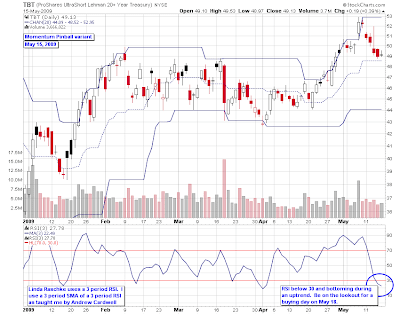In the summer of 2005, gold began its run from $418 to $725, while the summer of 2007 saw gold start its run from $657 to $1011. We are now in the summer of 2009. Can we learn anything from studying the past two gold runs?
We'll see. Here's some similarities between 2005 and 2007:
1. The 2005 gold bull started July 18. It kicked off with a 10 winning weeks in 12, gaining 13% over those 12 weeks. The 2007 gold bull began on August 20 with 11 winning weeks in 12, gaining 26% over that initial thrust.
2. The 2005 gold bull experienced a 4-week basing period from early October through early November. The 2007 gold bull, which climbed faster earlier, "rested" for 5 weeks during mid-November through mid-December.
3. After these resting periods, both gold bulls went on 4-5 week runs gaining ~14%.
After that, the similarities end. The 2007 gold bull then experienced another 5-week basing period before a final push to $1011, gaining 11% over a final 4-week thrust ending in mid-March 2008.
The 2005 gold bull had a nice 4-week run starting at Christmas gaining 12%, then had a prolonged 8-week resting period from late-January to mid-March 2006 before a spectacular final 7-week push in which gold gained 30% by mid-May 2006. It's no coincidence that the longer basing period resulted in a big finish.
The post-2000 high for gold going into the 2005 run was $454. Gold made a new high for the new millennium during week 9 of the initial 2005 thrust. Going into the 2007 run, the post-2000 high was $725 which gold surpassed during week 5 of the first 12-week leg.
If we have started a new gold bull, it began on July 13, 2009. Thanks to a magnificent rally today, we have now experienced 3 winning weeks in a row ($913 on 7/10 to $937 on 7/17, $951 on 7/24 and $954 on 7/31) where gold has gained a total of 4.5%.
If history holds, gold will continue to rise through early-October with an expected setback week or two mixed in. The initial thrust should find gold topping between $1030 to $1140 and surpassing its all-time high close of $1011 sometime in mid-August to mid-September.
Then there will be a month-long basing period before another 4-5 week run that will take us into January. After another resting period, we'll be ready for the final leg.
Note that if the first 12-week thrust results in relatively small gains (less than 15%), then under the Elliott Wave alternation principal we should expect the final push to be significantly larger. See the 2005 structure (13% first wave, 30% last wave). On the other hand, if the initial push is large (over 25%), then we should expect the final thrust to be relatively smaller. See the 2007 structure (26% first wave, 11% last wave).
As for where gold eventually tops in the Spring of 2010, the inverted Head & Shoulders pattern projects a top of $1379, while $1357 is a 360 degree turn on the Gann Square of 9 from $1011.
It will be interesting to see whether we are in the midst of a new gold bull run, and if so, how it will unfold in comparison to prior bulls.
PS I should note that according to Alf Field, the 2005 and 2007 gold runs were Waves 3 and 5 of Major Wave One which took gold from $256 to $1011. If we are beginning a new up Wave, it will be Wave 1 (or 3) of Major Wave Three, and might well behave differently than did Waves 3 and 5 in Major Wave One.
Louis XIV - Busts | TRUDON
4 days ago













![[Most Recent Quotes from www.kitco.com]](http://www.kitconet.com/images/live/s_gold.gif)
![[Most Recent USD from www.kitco.com]](http://www.weblinks247.com/indexes/idx24_usd_en_2.gif)







